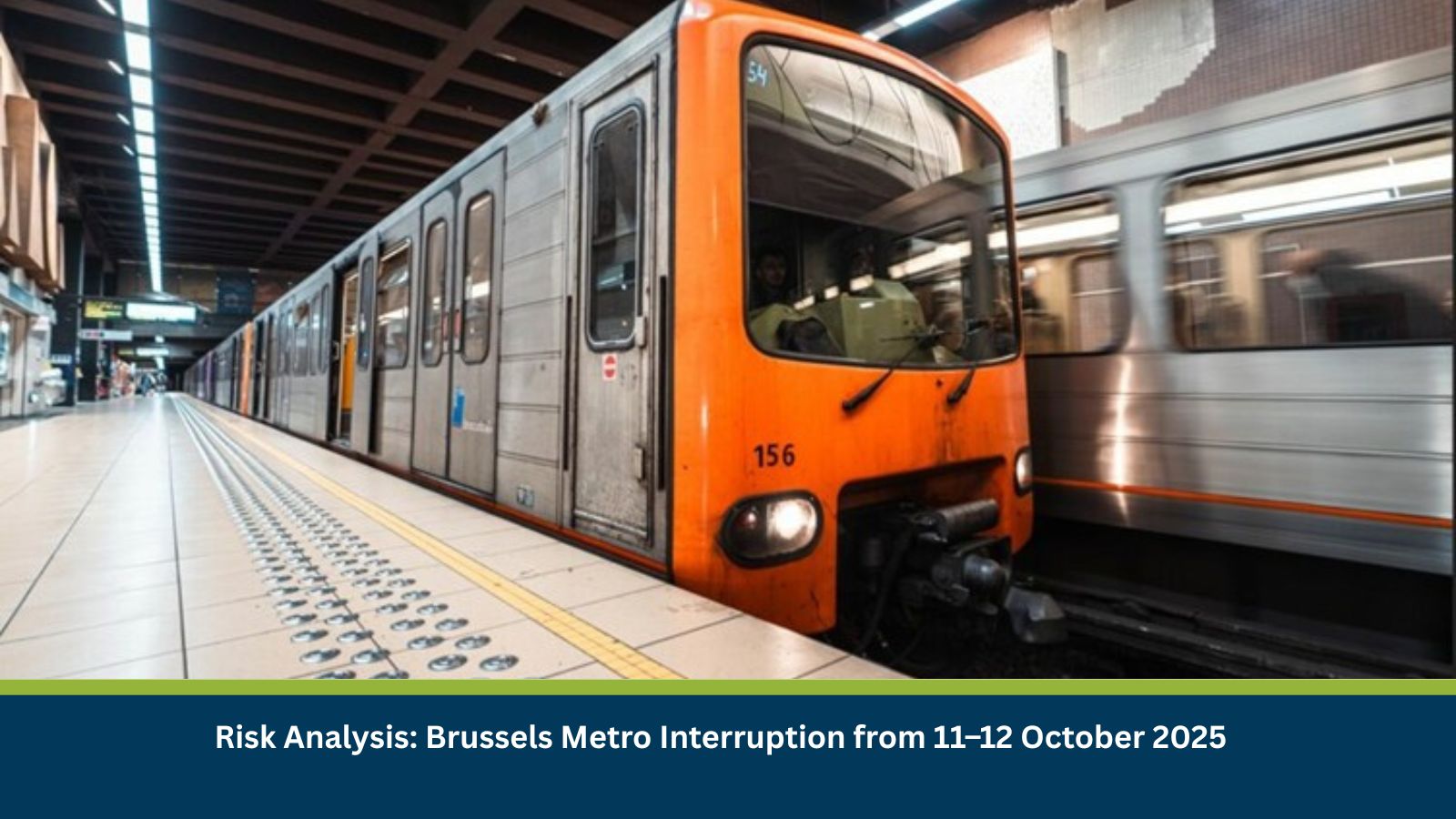What is Risk Analysis in the Context of Travel Risk Events
Travel-risk analysis evaluates how planned or unplanned transport changes affect mobility, business continuity, and public safety. In Brussels, recurring weekend works on the STIB/MIVB network are routine for asset renewals. While safety risks are low, network capacity cuts drive congestion, longer journeys, and pressure on replacement services – requiring proactive route planning and clear traveler communications.
Executive Summary
- Date of Incident: 11–12 October 2025
- Location: Brussels, Belgium
- Risk Category: Travel Risks
- Severity Score: 3/5
- Confidence Level: 95%
A scheduled interruption will suspend Metro Lines 2 and 6 between Yser and Elisabeth all weekend. As these semi-circular lines anchor key interchanges (e.g., Rogier, Arts-Loi, Gare du Midi), the closure will materially slow intra-city trips and increase reliance on trams, buses, and walking. Replacement buses will ease demand but face surface congestion. Impact is moderate: weekend timing limits commuter exposure, but tourism, retail, and on-call operations will feel delays.
Current Updates
Metro services on lines 2 and 6 are officially scheduled to be interrupted between Yser and Elisabeth stations in Brussels for the entirety of Saturday, 11 October, and Sunday, 12 October 2025. This planned closure is for maintenance or upgrade purposes and will necessitate alternative transport arrangements for passengers relying on these key urban lines.
Known Hotspots and Sensitive Areas
High impact: Station areas Yser–Elisabeth corridor, Rogier (interchange), Arts-Loi (EU/government district), Gare du Midi (international rail hub).
Medium: City centre retail axes (Boulevard Anspach, Dansaert) with footfall shifts; healthcare and hospitality near closed stations.
Low: Peripheral neighborhoods with alternate tram/bus coverage but susceptible to longer waits.
Impact on Transportation and Services
Expect replacement buses and heavier loads on trams/buses parallel to Lines 2/6. Road pinch-points near the inner ring may slow surface operations. Taxis/ride-hailing will see surge demand and extended ETAs. Rail (SNCB/NMBS) and intercity links remain available, but station interchanges may be crowded. Businesses near closed stations can see reduced footfall and staff delays; customer appointments may require rescheduling or remote options.
Recommended Actions
- Immediate (Mobility): Circulate route maps and live-travel links (STIB/MIVB app). List tram/bus substitutes for each impacted site; advise +15–30 minutes buffer.
- Operational: Enable remote work for non-critical weekend tasks; for essential staff, offer flexible shifts, taxi vouchers, or car-pooling.
- Customer & Stakeholders: Proactively confirm opening hours, access routes, and delivery windows; publish advisories on websites and venue signage.
- Continuity: Assign an on-duty coordinator to monitor crowding/ETA changes and trigger back-up arrangements (courier reroutes, temporary staffing).
- Safety: Remind travelers about platform crowd management and pick-pocket awareness on replacement services.
Multidimensional Impact
The shutdown precedes the national action day on 14 October, when wider transport disruption is expected. Combined effects may amplify public frustration, strain bus fleets, and complicate event logistics. Localized air-quality upticks are possible from added road traffic, though transient.
Emergency Contacts
- Emergency: 112
- Police: 101
- Fire/Ambulance (urgent): 100
- STIB/MIVB Info: +32 (0)70 23 2000
- City of Brussels: +32 (0)2 279 22 11
Final Thoughts
The trajectory suggests a short, planned, and contained disruption, with services expected to normalize by Sunday night. Key watchpoints include overcrowding on replacement buses, traffic bottlenecks in the inner ring, and congestion at major hubs such as Rogier, Arts-Loi, and Midi. Organizations should focus on ensuring personnel safety and preserving operations through remote work arrangements, flexible scheduling, and proactive client communication. Leveraging real-time travel advisory tools can help minimize continuity risks and prepare for cumulative impacts leading up to the 14 October national action.
Stay ahead of operational risks with real-time alerts, scenario modeling, and expert advisories with datasurfr’s Predict. Start your 14-day free trial of Datasurfr’s Risk Intelligence Platform today.






